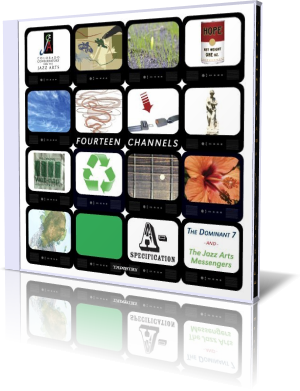
When budgets are slashed for educational programs at any
level, arts programs are usually the first to take a hit. So it is
refreshing when an institution not only continues to educate but also
encourages the creativity of its students.
The Colorodo Conservatory for the Jazz Arts is a non-profit
organization based in Denver. It offers ensembles, camps and classes to
provide young people with unique opportunities for the study and
performance of jazz music, culture and history. As a result, two ensembles
of students, ages 16 to 24, recorded their first album of original music:
Fourteen Channels on the Tapestry label.
The Jazz Arts Messengers are David Reid on alto sax and clarinet, Gregory
Wahl on alto sax, Sam Crowe on tenor sax and flute, Evan White on tenor
sax, Carly Meyers on trombone, Mike Robinson on guitar, Sam Yulsman on
piano, Brian Wilson on bass and Cameron Hicks on drums.
“Song for Robert Rauschenberg,” penned by Yulsman, features solos by the
pianist and Reid. The entire horn section carries the melody during the
opening sequence. The bass and drums underscore the piece effectively.
Reid then shows his skills on the alto sax, playing with hints of Maceo
Parker, followed by Yulsman’s piano solo. Hicks enjoys some crisp cymbals
play during the latter solo.
“Antics” is an easygoing piece written by Hicks. Soloists are Hicks,
Yulsman and Reid. Robinson’s rhythm guitar and Wilson’s bass supplement
the leads. Accompanied only by Yulsman, Hicks works the entire kit during
his solo.
The Dominant 7 are Noah Fulton-Beale on trumpet, Daniel Weidlein on alto,
soprano and tenor saxophones and flute, Kyle Etges on baritone sax, Ryan
Thrush on guitar, Stephen Thurston on piano, Lelah Simon on bass, Susan
Richardson on drums and Kevin Miles, who plays bass on “Wetnap.”
“An Ounce of Hope,” composed by Weidlein, features solos by Thurston,
Weidlein and Richardson. Its energetic beat features some solid rim shots
and toms work by Richardson. Thurston is in a zone during his brief solo.
After a brief phrase by the horns, Thurston and Richardson enjoy an
interlude. This selection is only three and a half minutes long, all too
brief for the amount of energy demonstrated. It bounces from melody to
solo a little too quickly, but a strong point is Richardson’s versatility
on the drum kit.
“Hop On, Buckle Off,” by Richardson, begins with an ominous piano solo,
with other instruments joining in. Fulton-Beale fills on muted trumpet.
Solos are by Fulton-Beale, Thrush, Etges and Richardson. The song goes
through several moods, beginning with a blues motif. Then, the pace picks
up as Thrush solos on electric guitar, making it more of a brooding rock
song. Richardson plays like a rock drummer. During one sequence, muted
trumpet, bass, piano and baritone sax all seem to be doing their own
thing, with the drums holding it together. Etges makes the baritone wail
on high notes and rumble on low ones. Just as it seems as if the band were
about to lose control, the pace shifts down for Richardson’s solo. The
music slowly transitions back to the bluesy feel of its beginning.
The 14 songs, or channels, are split between the two ensembles, with the
tracks alternating from The Jazz Arts Messengers to The Dominant 7. These
17 young men and women are skilled musicians worthy of notice. And their
recording gives hope that the art of jazz is not entirely lost.
Web site:
www.jazzarts.org



